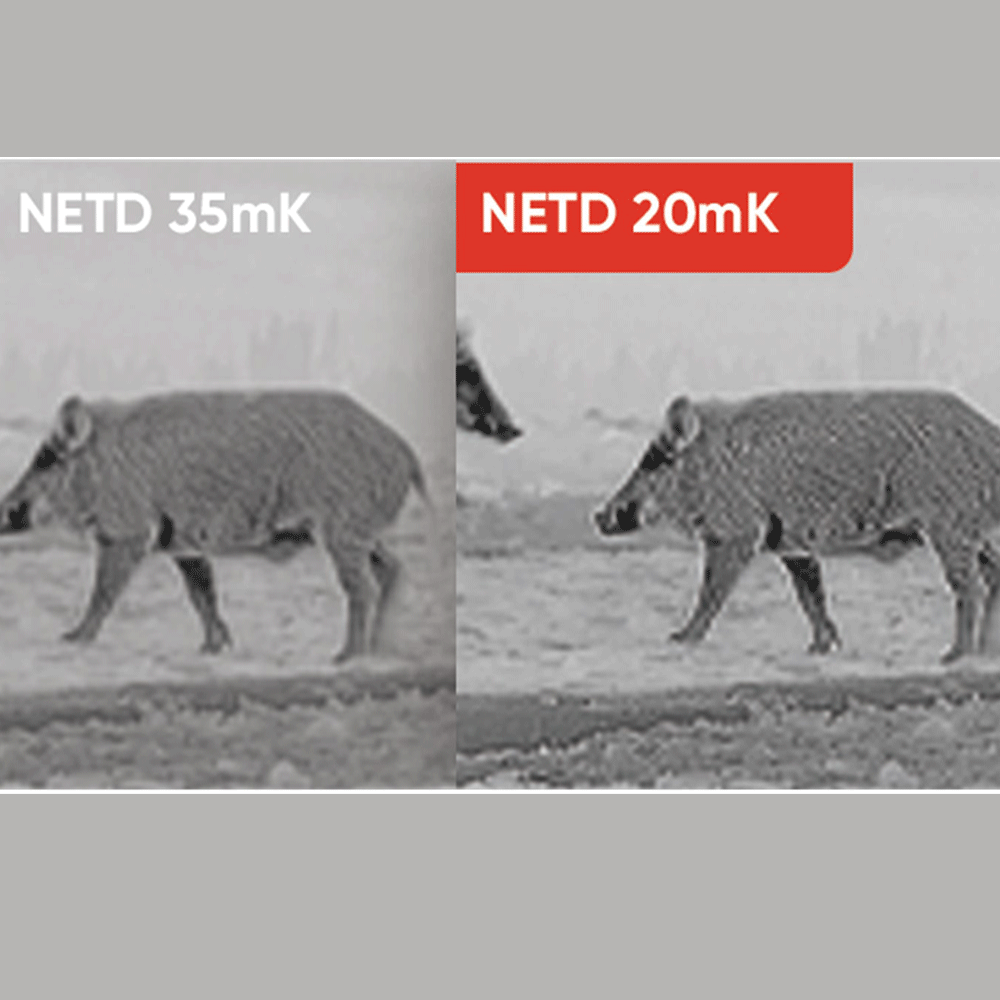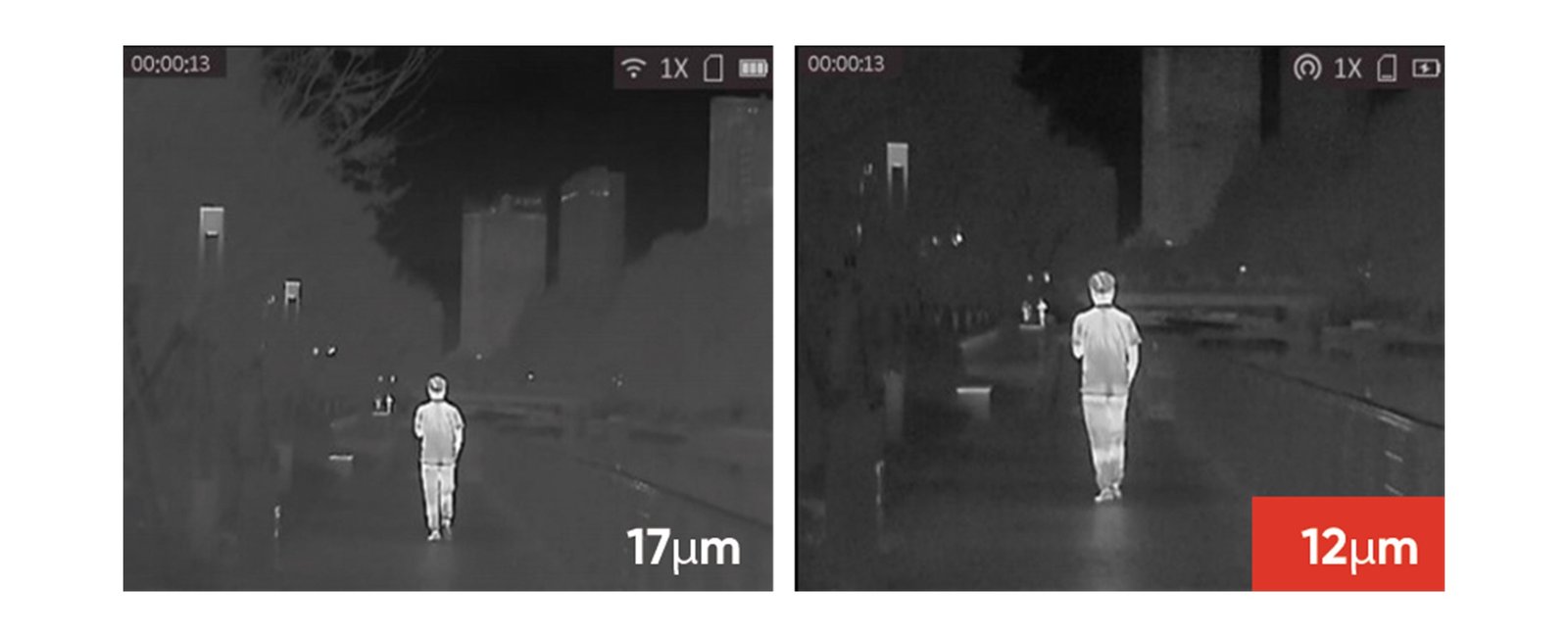
NETD stands for Noise Equivalent Temperature Difference and is crucial in the realm of thermal imaging. It indicates how effectively a thermal scope can detect small temperature changes. A lower NETD value means the thermal scope is more sensitive, enabling it to capture minute temperature differences. High sensitivity is essential for precise thermal detection, as NETD directly influences the quality of thermal images by minimizing noise. Understanding NETD is vital when selecting the right thermal scopes, ensuring you achieve accurate and clear thermal images.

Understanding NETD
What is NETD?
NETD stands for Noise Equivalent Temperature Difference. It shows how well a thermal camera can spot tiny heat changes. This is important because it tells us how sensitive the device is. NETD is measured in millikelvin (mK). It shows when the heat signal matches the noise signal. A lower NETD means the scope sees smaller heat differences, making it more sensitive.
Why NETD Matters in Thermal Imaging
NETD is key for good thermal imaging. It affects how sensitive and accurate the devices are at spotting small heat changes. Devices with low NETD give better pictures, showing more details even in tough weather like cold, rain, or fog.
Main Benefits of Low NETD:
Better Image Quality: Lower NETD gives clearer pictures with more detail.
Higher Detection Accuracy: Devices find smaller heat changes, important for exact readings.
Wider Use Range: Good thermal systems work in many areas like security and wildlife watching.
By making NETD better with new tech, like better sensors and signals, thermal systems give clearer images and more exact temperature readings. This helps improve safety and decisions in many fields.
How NETD is Measured
Measurement Process
To know how NETD is measured, you need to learn about thermal imaging. NETD shows how well a camera sees tiny heat changes. It captures heat from things and turns it into pictures. We measure NETD in milli-Kelvin (mK). This tells us the smallest temperature change the scope can see.
First, the camera takes in infrared light from what it sees. The sensor changes this light into an electric signal. This signal is processed to make a thermal picture. The NETD value comes from comparing object heat with background noise. A lower NETD means the camera spots smaller heat changes, giving clearer images.
Factors Affecting NETD Values
Many things can change NETD values and affect temperature readings. Knowing these helps pick the best thermal scope for you.
Sensor Quality: Good sensors find smaller heat differences, lowering NETD values for better pictures.
Ambient Temperature: Hot or cold weather can raise noise levels, making it harder to spot small heat changes.
Lens Quality: Lenses focus infrared light on sensors. Better lenses cut noise and help see tiny temperature differences.
Signal Processing: Smart processing makes it easier to tell apart objects and noise, improving accuracy and lowering NETD values.
Calibration: Regular checks keep cameras accurate by keeping low NETD, boosting performance.
By knowing these factors, you choose wisely when buying a thermal scope. Lower NETD means seeing smaller temperature changes clearly and accurately, which is key in security, watching animals, and checking machines.
How NETD Affects Thermal Imaging
Looking at Different NETD Levels
Different NETD levels change how thermal cameras work. Lower NETD gives clearer pictures and better temperature checks. This means a camera with low NETD sees tiny heat changes, making images sharper. But, higher NETD makes more noise, so it’s hard to see heat differences. Even small changes in NETD can affect picture quality and accuracy.
Why Lower NETD is Better
Picking a scope with low NETD has many perks:
Better Picture Quality: Low NETD cuts noise, showing clearer pictures. This is key for security or watching animals.
More Accurate Detection: With low NETD, scopes find tiny heat changes. This makes readings better for things like factory checks or rescue missions.
Works Well in Bad Weather: Low NETD keeps performance steady in tough weather. In cold, rain, or fog, cameras stay sensitive and accurate.
Knowing how NETD affects imaging helps you choose the best scope. A lower NETD gives top image quality and detection skills, improving your work in many areas.
Uses of NETD in Different Areas
Military and Defense
In the military, thermal scopes are very important. They help find heat changes in different places. You can see targets even when it’s totally dark. Spotting small heat changes helps find threats. A cooled camera makes this better with more sensitivity. This means finding tiny heat changes is easier, which is key for sniper systems. Defense uses thermal imaging that depends on NETD for being right and trustworthy.
Watching Wildlife
For watching animals, thermal scopes are super helpful. They let you see animals without bothering them. You can spot little heat changes to track animals at night. Thermal cameras’ sensitivity gives clear pictures, which is great for studying how animals act. With a handheld camera, you can move around and watch wildlife where they live naturally. The special lens helps you see even tiny movements.
Industrial and Business Uses
In factories and businesses, thermal scopes do many jobs. They’re used to check machines and keep things safe. Thermal work checks for overheating or problems in machines. By spotting small heat changes, you stop dangers before they happen. Cars get safer with this tech by using it in their systems. In business places, measuring body temperature gets better with these cameras’ help. The special systems give exact readings to keep everyone safe.
Why NETD Matters in Thermal Scopes
Making Pictures Better
NETD, or Noise Equivalent Temperature Difference, is key to better pictures in thermal scopes. A lower NETD means the scope is more sensitive to heat changes. This helps it capture detailed and clear thermal images. Many experts say NETD affects how good the pictures are. A scope with a low NETD gives clearer images with less noise, showing details even when it’s hard to see.
“NETD is like contrast for regular cameras,” says a thermal imaging expert. This shows how important NETD is for scenes where things have similar temperatures.
Boosting Detection Skills
For finding things, NETD is very important. A lower NETD helps your scope spot small temperature changes well. This matters for finding and recognizing objects. At long distances, weather can make this hard, but a low NETD scope does better.
Good Things About Low NETD for Finding Stuff:
Fast and Accurate Heat Change Spotting: Low NETD cameras find temperature changes quickly and accurately. This helps find problems fast.
Fewer Wrong Alarms: High NETD cameras might show grainy pictures and cause false alarms. Lower values fix this, making detection more reliable.
Knowing why NETD matters helps you pick the right gear. A lower value makes pictures clearer and finding things easier, improving your thermal imaging work.
New Tech Making NETD Better
Recent Tech Changes
New technology has made thermal cameras work better by lowering NETD. Engineers have built more sensitive detectors to see tiny heat changes. This means new sensors have lower NETD, giving clearer pictures.
Better Sensor Stuff: New sensor materials make them more sensitive to heat. These materials cut noise and help find temperatures accurately.
Smarter Signal Processing: Today’s thermal scopes use smart signal tricks. They tell real heat signals from background noise, making images clearer.
New Calibration Ways: Regular checks keep cameras sensitive over time. New ways of checking keep NETD low for steady performance.
AI and Machine Learning Use: With AI, thermal systems adjust settings on their own for better NETD. This gives clearer pictures and accurate readings.
These tech changes make thermal imaging more reliable, helping you spot temperature changes fast and right.
Future Thermal Imaging Trends
Looking ahead, some trends will make NETD even better in thermal systems, improving how they work for different uses.
Smaller Parts: As tech gets better, parts in thermal systems get smaller and work well. Smaller parts mean portable scopes with better NETD.
More Quantum Dots Use: Quantum dots might boost sensor sensitivity a lot. They could lower NETD, giving clear images in tough spots.
Mixing Systems Together: Using both thermal imaging and other tech like light cameras gives a full view of places. Mixed systems with good NETD help find things better.
Energy Saving Focus: Future systems will save power but still perform well by keeping low NETD, ensuring good images without using much energy.
Knowing these trends helps you pick the best thermal gear. Understanding these advances lets you choose tools that work great and last long.
NETD is crucial for better thermal imaging. It makes scopes more sensitive and accurate. This helps you notice small temperature changes easily. As technology gets better, NETD improves too. This means clearer images and more trustworthy temperature checks. These advancements expand how we use thermal imaging, like in security or watching animals. Knowing about NETD helps you pick the right thermal scope. This way, you get the most out of its great features and many uses.
Welcome to AirSeeker, an ODM solution provider with 12 years of experience specializing in thermal imaging technology. We are dedicated to offering top-notch customized solutions for outdoor hunting enthusiasts, outdoor observers, shooting enthusiasts, farm monitoring, and law enforcement agencies. Product ranges from thermal scope for rifles, thermal clip on, thermal monocular, binoculars, including night vision clip on; All products are not only truly waterproof and impact-resistant but also feature sniper-level ballistic calculation technology, ensuring clear and reliable visibility in any environment.
Business Cooperation : info@airseekertec.com
